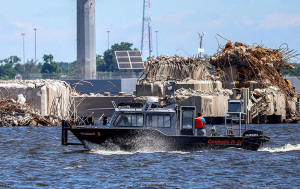Biden administration touts quick Baltimore channel reopening
 Send a link to a friend
Send a link to a friend
 [June 12, 2024]
By David Shepardson [June 12, 2024]
By David Shepardson
WASHINGTON (Reuters) - This week's reopening of Baltimore's main
shipping channel - less than three months after the Key Bridge collapse
- was due to expertise gained from a COVID-era task force, a highway
overpass collapse and the 2021 infrastructure law, government officials
said.
The deadly March 26 collision of the cargo ship Dali into the Francis
Scott Key Bridge had paralyzed a major transportation artery for the
U.S. Northeast.
Within hours, President Joe Biden directed aides to get the channel
reopened, the bridge rebuilt and vowed the federal government would
cover the full costs. His administration has previously faced criticism
for its initial response to the 2023 derailment of a train in Ohio.
Federal officials said on Monday that full access to the channel had
been restored after the removal of 50,000 tons of debris. On Wednesday,
Maryland Gov. Wes Moore and other officials are holding a press event to
mark its reopening.
After the collapse, the Coast Guard quickly established a Unified
Command to coordinate search, recovery and response efforts. It oversaw
more than 1,500 individual responders that involved 56 federal, state,
and local agencies along with 500 specialists operating a fleet of boats
to remove steel and concrete debris and address shipping impacts.

"I think that one of the most important things we did was establishing
the unified command," White House deputy chief of staff Natalie Quillian
told Reuters.
"So there was clear command and control of what is a very complex
operational challenge across stakeholders from federal and state
government and the private sector."
For example, the U.S. Army Corps of Engineers (USACE), which oversees
the federal navigation channel, was able to tap the U.S. Navy Supervisor
of Salvage for the massive operation.
"That's exactly the power of the unified command," said Col. Estee
Pinchasin, Baltimore district commander for USACE, which by early April
had set an ambitious timetable for reopening the channel.
A council created by Biden in 2021 to address COVID-related supply chain
shortages was convened shortly after the bridge collapse and federal
agencies opened specialized offices to monitor supply chain issues.
[to top of second column]
|

A small boat cruises past the clean-up operations at the Francis
Scott Key Bridge as the main shipping channel prepares to fully
reopen, in Baltimore, Maryland, U.S., June 10, 2024. REUTERS/Evelyn
Hockstein/File Photo

"We developed these protocols during the first year of the
pandemic," White House National Economic Council director Lael
Brainard said. "This very intensive sprint that we immediately
activate to basically troubleshoot and share information."
Brainard also cited lessons learned from the June 2023 collapse of
an Interstate-95 overpass in Philadelphia that was quickly reopened.
"The I-95 collapse was such a rapid response that we had a sense of,
'OK we know what to do," he said.
Brainard and Transportation Secretary Pete Buttigieg led a call to
ensure business, labor and port operators had the "same information
to help them rapidly develop workaround plans."
Both cited the $1 trillion infrastructure law that has dramatically
boosted spending on bridges and other projects as having given the
administration know-how and "muscle memory" to tackle big
challenges.
Buttigieg's office approved $60 million in emergency funds for
Maryland to rebuild and remove debris, while the U.S. Army Corps and
Coast Guard said on Tuesday they have spent nearly $100 million on
the bridge response and debris removal.
Buttigieg also repurposed a grant so more cargo area could be
established and waived hours of service limits for impacted
trucking.
"When the president of the United States says that every part of
this administration should do everything you can think of within the
limits of law - we can actually move quite quickly," Buttigieg told
Reuters.
A replacement bridge will cost an estimated $1.7 billion-$1.9
billion and federal officials are working to speed environmental
approvals. Maryland hopes it will be completed by late 2028.
(Reporting by David Shepardson; Editing by Edwina Gibbs)
[© 2024 Thomson Reuters. All rights reserved.]This material
may not be published, broadcast, rewritten or redistributed.
Thompson Reuters is solely responsible for this content.
 |